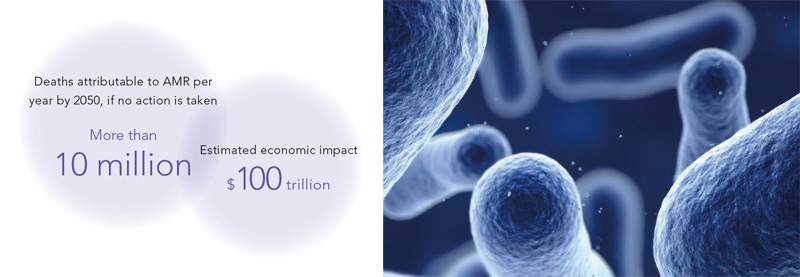Background of addressing the problem of antimicrobial resistance (AMR)
Antimicrobial resistance (AMR) is called a silent pandemic, and without countermeasures, it is estimated to cause 10 million deaths annually by 2050 with cumulative economic losses reaching $100 trillion.

In the future, lack of effective antibiotics could make routine medical interventions extremely dangerous or even impossible.
For these reasons, AMR must be regarded as a global, regional, and national priority for health organizations and governments, to be addressed with the utmost urgency on a global scale.
WHO and United Nations Initiatives to Tackle AMR
WHO Global Action Plan
- Global cooperation spearheaded by World Health Assembly
- Global Action Plan setting out five strategic objectives
- 1Improving awareness and understanding of antimicrobial resistance
- 2Strengthening the knowledge and evidence base through surveillance and research
- 3Reducing the incidence of infection through effective sanitation, hygiene and infection prevention measures
- 4Optimizing the use of antimicrobial agents in human and animal health
- 5Developing an economic case for sustainable investment
United Nations High-Level Meeting (September 2016)
- World leaders signaled an unprecedented level of attention to curb the spread of multidrug-resistant infections.
- Countries reaffirmed their commitment to develop national action plans on AMR.
- Leaders recognized the need for stronger systems to monitor drug-resistant infections and the volume of antimicrobials used in humans, animals and crops, as well as increased international cooperation and funding.
- Leaders also called for new incentives for investment in research and development of new, effective and affordable medicines, rapid diagnostic tests, and other important therapies to replace those that are losing their power.
WHO List of Antibiotic-Resistant “Priority Pathogens”
On February 27, 2017, the World Health Organization (WHO) published its first-ever list of antibiotic-resistant “priority pathogens,” a catalog of 12 families of bacteria that pose the greatest threat to human health. Stating that “Antibiotic resistance is growing, and we are fast running out of treatment options,” the WHO stressed the need to develop new antibiotics. The 12 pathogens on the list are divided into three categories according to the urgency of need for new antibiotics, with carbapenem-resistant bacteria slotting into the critical category where the need for new antibiotics is considered particularly urgent.
Critical Priority
| Acinetobacter baumannii | carbapenem-resistant |
|---|---|
| Pseudomonas aeruginosa | carbapenem-resistant |
| Enterobacteriaceae | carbapenem-resistant |
High Priority
| Enterococcus faecium | vancomycin-resistant |
|---|---|
| Staphylococcus aureus | methicillin-resistant vancomycin-resistant |
| Helicobacter pylori | clarithromycin-resistant |
| Campylobacter | fluoroquinolone-resistant |
| Salmonella species | fluoroquinolone-resistant |
| Neisseria gonorrhoeae | cephalosporin-resistant fluoroquinolone-resistant |
Medium Priority
| Streptococcus pneumoniae | Streptococcus pneumoniae |
|---|---|
| Haemophilus influenza | ampicillin-resistant |
| Shigella species | fluoroquinolone-resistant |
